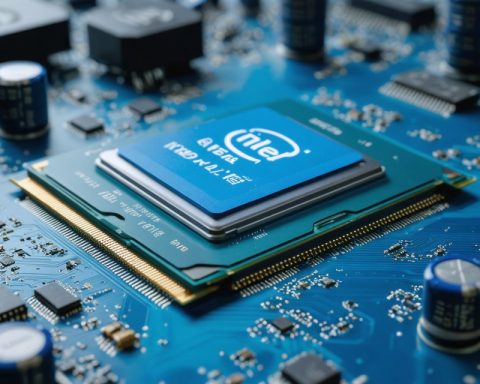- The European tech landscape is both promising and perilous, with AI at the center of both opportunity and challenge.
- Companies like SAP and RELX successfully integrate AI, showcasing its potential for significant growth and profitability.
- The launch of the low-cost AI model DeepSeek disrupted the market, highlighting vulnerabilities in AI hardware providers.
- Investors are increasingly demanding that AI applications yield tangible profits rather than mere promises.
- Surveys suggest skepticism about near-term AI profitability, but optimism remains for a substantial impact within five years.
- Financial experts warn that companies relying solely on high valuations without economic proof will face challenges.
- As the pivotal year 2025 approaches, AI firms are urged to demonstrate both innovation and profitability.
- Success in this evolving landscape requires not just creativity but a proven ability to generate real-world profits.
A whirlwind of promise and peril stirs the European tech landscape. The allure of artificial intelligence, an odyssey into the future, lures companies with visions of brilliance. Yet, as the horizon brightens, a shadow looms—a warning that echoes through the corridors of high finance: the need to prove AI’s worth in real profits is looming over Europe like a gathering storm.
Amidst this rush, firms like SAP and RELX, which cleverly weave AI into their fabric, continue to seduce investors with a blend of innovation and pragmatism. These companies have become harbor lights in turbulent seas, shining a beacon on the path from mere hype to tangible success. SAP’s remarkable rise to Europe’s pinnacle of valuation, eclipsing giants like Novo Nordisk, underlines an emblematic narrative of AI not just as a tool, but as a driver of substantial growth.
The launch of DeepSeek, a revolutionary low-cost AI model, rattled the market with an unexpected ferocity. Its impact was seismic, sparking a selloff that exposed the fragility of overvalued AI hardware providers such as ASM International and BE Semiconductor. As these titans grapple with the aftermath, a clear message emerges: in the high-stakes game of AI, adaptability and integration can trump raw supply.
But the clock ticks audibly for AI purveyors. Voices from seasoned investors such as Lazard and Schroders urge a shift from nebulous promises to concrete action. Viable AI applications must rise, not as mere abstractions, but as real solutions generating substantial revenue streams. Ratings from a Fidelity survey suggest a cautious landscape; 72% of analysts foresee no major profitability shift next year. Yet, the narrative spins a different tale over five years—a hopeful crescendo building.
Amid the clamor, financial titans like Amundi issue precise warnings: euphoria cannot overshadow economic scrutiny. Firms trading on ethereal value alone stand precarious. The patience of market players thins as 2025 edges closer, a year pegged by many experts as pivotal for AI firms to unfurl the results of their grand experiment.
The key takeaway reverberates with urgency—a call to action for the ambitious and insightful. As AI carves its indelible mark across industries, only those who leverage its potential to create real-world profit will endure. The clock is not just ticking; it’s roaring. To thrive in this new era, AI companies must dazzle not just with innovation, but with a proven track record of profitability—a dual mandate that will separate the sustainers from the dreamers.
The AI Revolution in Europe: Profits, Pitfalls, and the Path Forward
Navigating the European AI Landscape
The European tech scene is at a crossroads, with artificial intelligence (AI) being both a hopeful promise and a potential peril. AI’s allure lures firms with its visionary prospects, while a pressing need for measurable profitability looms ominously, echoing a caution that reverberates particularly within financial circles. Amidst this high-stakes environment, companies like SAP and RELX have managed to weave AI seamlessly into their operations, proving that strategic integration can serve as a guiding light toward tangible success.
Key Developments and Insights
1. Leadership in AI Integration:
– SAP’s Strategic Ascent: SAP’s journey toward becoming one of Europe’s most valuable companies showcases the profound impact of AI as not just an adjunct tool, but a primary driver of growth. By harnessing AI to optimize their offerings, SAP has surpassed industry giants like Novo Nordisk in valuation, illustrating AI’s capability to underpin substantive business success.
– RELX’s Information Solutions: RELX has also adeptly utilized AI to enhance their information solutions, providing robust tools for data-driven insights. This has strengthened their market position and underscored the effectiveness of thoughtful AI deployment.
2. Market Disruptions: The DeepSeek Model:
– The introduction of DeepSeek, a groundbreaking low-cost AI model, sent shockwaves through the market, prompting a reevaluation of AI hardware providers like ASM International and BE Semiconductor. This highlighted a critical insight: adaptability and seamless integration of AI services are more crucial than merely supplying technological components.
3. Investor Sentiments and Economic Acknowledgments:
– Investors from entities like Lazard and Schroders emphasize the urgent need for AI companies to convert potential into pragmatic, revenue-generating applications. Similarly, a Fidelity survey finds that a majority of analysts (72%) remain skeptical about immediate profitability shifts, pushing companies to focus on long-term profitability strategies.
4. Future Outlook and Strategic Recommendations:
– Predictions converge on 2025 as a watershed year, where AI firms will need to substantiate their worth through demonstrable outcomes. Expert opinions advise focusing on real-world applications and economic scrutiny over speculative euphoria to ensure sustainable growth.
How-To Capitalize on AI Innovations
– Adopt a Dual Mandate Strategy:
– Innovate while ensuring fiscal accountability. Companies should prioritize identifying segments where AI can add new value and simultaneously cultivate a path to profitability.
– Leverage Data Analytics:
– Utilize AI for predictive analytics to enhance decision-making, thus improving operational efficiency and competitive advantage.
– Focus on Tangible Use Cases:
– Develop and market AI applications that address specific industry needs, such as automation in manufacturing or predictive maintenance in logistics.
Controversies and Limitations
– Ethical and Regulatory Concerns:
– As AI cements its place in various sectors, ethical concerns, and data privacy issues remain profound. Companies will face scrutiny regarding how AI technologies affect consumers and data management practices.
– Economic Disparities:
– Talent and deployment inequalities may grow, particularly across the EU, where differing resource accessibility could widen the tech gap between nations.
Conclusion: Actionable Recommendations
1. Invest in Transparent AI Initiatives:
– Companies need to maintain transparency with stakeholders about AI’s role and the ROI potential in their strategic framework.
2. Partnerships and Collaborations:
– Form alliances with research institutions and tech innovators to stay at the forefront of dynamic AI advancements.
3. Continuous Learning and Adaptation:
– Foster a culture of constant learning within organizations to adapt to rapid technological shifts and regulatory changes.
By establishing AI strategies that prioritize real profitability and addressing regulatory standards, organizations will be better positioned to thrive in the evolving European AI landscape.
Given the ongoing AI revolution, readers interested in understanding the broader implications of AI and technology trends should explore insights from established tech thought leaders on TechCrunch, offering numerous resources on how emerging technologies are shaping tomorrow’s economy.















